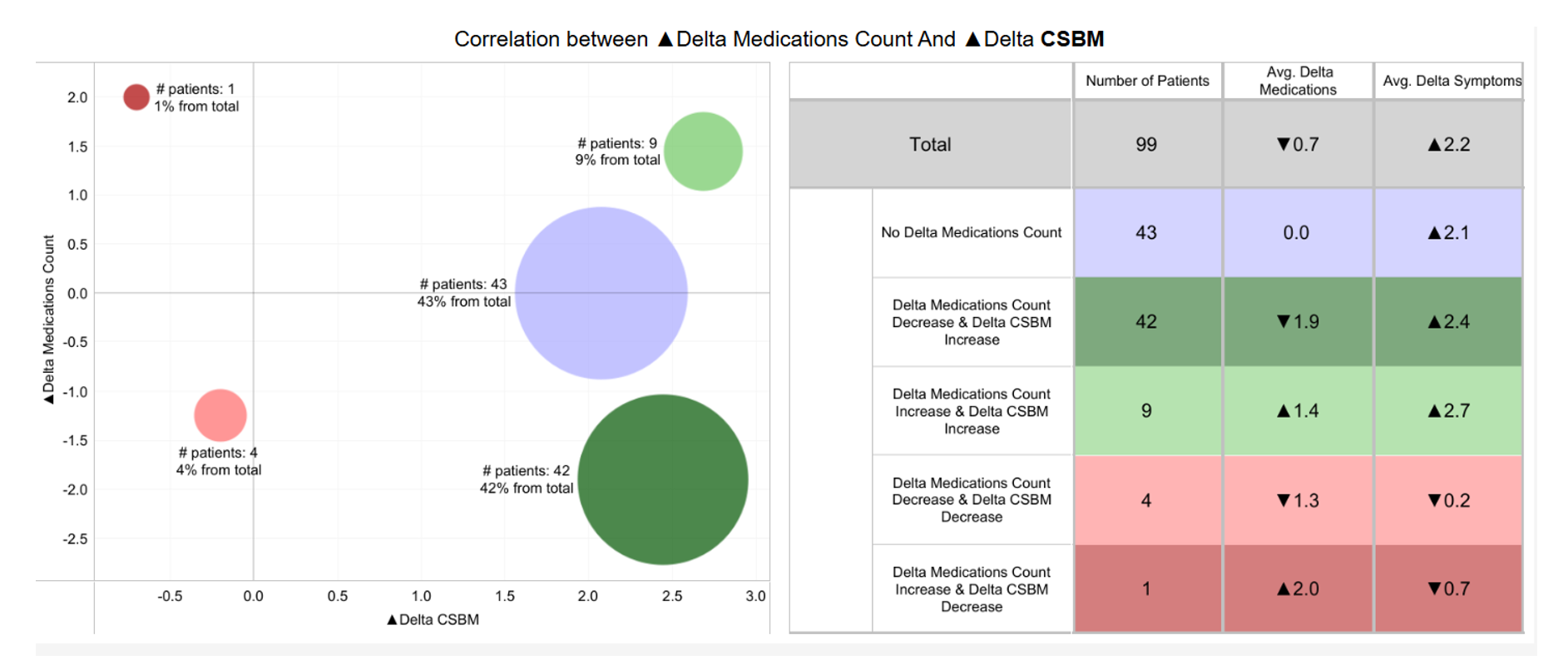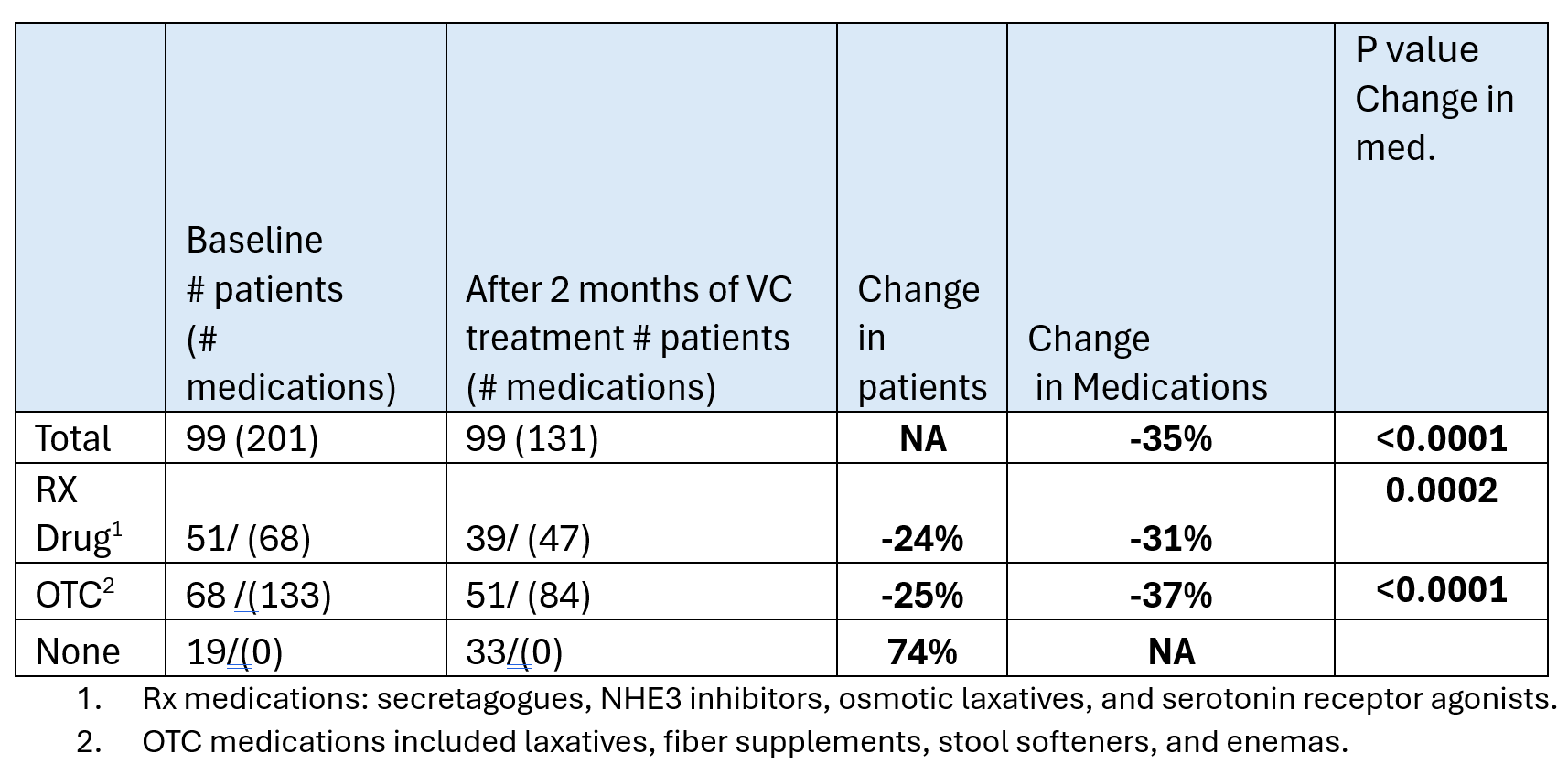Monday Poster Session
Category: Functional Bowel Disease
P2936 - The Impact of Vibrating Capsule Treatment on Concomitant Constipation Medication Use
Monday, October 27, 2025
10:30 AM - 4:00 PM PDT
Location: Exhibit Hall
- LN
Lelia Neshatian, MD
Stanford University
Stanford, CA
Presenting Author(s)
Leila Neshatian, MD1, Ali Rezaie, MD, MSc2, Satish SC. Rao, MD, PhD, FACG3
1Stanford University, Stanford, CA; 2Cedars-Sinai Medical Center, Los Angeles, CA; 3Augusta University Medical Center, Augusta, GA
Introduction: Chronic Idiopathic Constipation (CIC) is commonly managed with pharmacologic treatments, including over-the-counter (OTC) and prescription (RX) medications. However, many patients report dissatisfaction due to limited efficacy and adverse effects. The Vibrating Capsule (VC), an FDA-approved non-pharmacologic treatment, offers an alternative, though its effectiveness in reducing a need for other constipation treatments is unclear.
The aim was to evaluate the impact of VC on the use of constipation medications and its correlation with symptom relief.
Methods: We performed a post-marketing analysis of CIC patients, prescribed 5 VC capsules weekly. Data on medication use and patient-reported symptoms as recorded on a digital stool diary were collected at baseline (pre-treatment) and 2 months after treatment.
Results: Of 1,143 patients prescribed VC, 99 kept diaries for 2 months and provided information about their constipation medication use. Mean age was 53 years, with 46% over 55; 87% were women. After 2 months, 35% of patients significantly decreased (P< 0.0001) use of other constipation medications, and 74% no longer required medication (P=0.0238) (Table 1). The proportion of patients using ≥3 medications dropped from 37% to 18% (P< 0.0001), and those on 1–2 medications rose from 43% to 48% (P=0.0366). The average number of medications per patient declined significantly from 2.0 to 1.3 (P< 0.0001) (Fig 1).The number of complete spontaneous bowel movements (CSBM) increased by 2.2 /week, stool consistency (BSS) improved by 1.1 points and straining effort (1–4 scale) decreased by 1.2 points (all P< 0.0001); toileting time decreased by 9.7 minutes (P=0.001). A correlation analysis of medication changes and CSBM showed that 42% of patients decreased medication use and had a significant increase of 2.4 CSBM/week (P< 0.0001). Also, 43% maintained their medication use, with a similar increase of 2.1 CSBM/week. (P< 0.0001) and 10% increased their medication use with an increase of 2.7 CSBM/week. (P=0.0004).
Discussion: VC therapy significantly reduced constipation medication use and improved clinical outcomes in patients with CIC. Correlation analysis showed that reducing or maintaining medication use was associated with meaningful improvements in constipation symptoms. These results highlight that VC is an effective treatment for constipation and decreases the use of other medications whilst improving bowel symptoms.

Figure: Figure 1: Patient Distribution Based on Medication Reduction and CSBM Improvement

Figure: Table 1: Change in Medication Use (OTC & RX) Over Two Months of VC Treatment
Disclosures:
Leila Neshatian indicated no relevant financial relationships.
Ali Rezaie: Ardelyx, Blueprint Medicine and Salix Pharmaceuticals – Consultant. Gemelli Biotech, and Good LFE – Equity stake.
Satish Rao: Laborie Medical Technologies – Grant/Research Support. Vibrant Ltd – Advisory Committee/Board Member.
Leila Neshatian, MD1, Ali Rezaie, MD, MSc2, Satish SC. Rao, MD, PhD, FACG3. P2936 - The Impact of Vibrating Capsule Treatment on Concomitant Constipation Medication Use, ACG 2025 Annual Scientific Meeting Abstracts. Phoenix, AZ: American College of Gastroenterology.
1Stanford University, Stanford, CA; 2Cedars-Sinai Medical Center, Los Angeles, CA; 3Augusta University Medical Center, Augusta, GA
Introduction: Chronic Idiopathic Constipation (CIC) is commonly managed with pharmacologic treatments, including over-the-counter (OTC) and prescription (RX) medications. However, many patients report dissatisfaction due to limited efficacy and adverse effects. The Vibrating Capsule (VC), an FDA-approved non-pharmacologic treatment, offers an alternative, though its effectiveness in reducing a need for other constipation treatments is unclear.
The aim was to evaluate the impact of VC on the use of constipation medications and its correlation with symptom relief.
Methods: We performed a post-marketing analysis of CIC patients, prescribed 5 VC capsules weekly. Data on medication use and patient-reported symptoms as recorded on a digital stool diary were collected at baseline (pre-treatment) and 2 months after treatment.
Results: Of 1,143 patients prescribed VC, 99 kept diaries for 2 months and provided information about their constipation medication use. Mean age was 53 years, with 46% over 55; 87% were women. After 2 months, 35% of patients significantly decreased (P< 0.0001) use of other constipation medications, and 74% no longer required medication (P=0.0238) (Table 1). The proportion of patients using ≥3 medications dropped from 37% to 18% (P< 0.0001), and those on 1–2 medications rose from 43% to 48% (P=0.0366). The average number of medications per patient declined significantly from 2.0 to 1.3 (P< 0.0001) (Fig 1).The number of complete spontaneous bowel movements (CSBM) increased by 2.2 /week, stool consistency (BSS) improved by 1.1 points and straining effort (1–4 scale) decreased by 1.2 points (all P< 0.0001); toileting time decreased by 9.7 minutes (P=0.001). A correlation analysis of medication changes and CSBM showed that 42% of patients decreased medication use and had a significant increase of 2.4 CSBM/week (P< 0.0001). Also, 43% maintained their medication use, with a similar increase of 2.1 CSBM/week. (P< 0.0001) and 10% increased their medication use with an increase of 2.7 CSBM/week. (P=0.0004).
Discussion: VC therapy significantly reduced constipation medication use and improved clinical outcomes in patients with CIC. Correlation analysis showed that reducing or maintaining medication use was associated with meaningful improvements in constipation symptoms. These results highlight that VC is an effective treatment for constipation and decreases the use of other medications whilst improving bowel symptoms.

Figure: Figure 1: Patient Distribution Based on Medication Reduction and CSBM Improvement

Figure: Table 1: Change in Medication Use (OTC & RX) Over Two Months of VC Treatment
Disclosures:
Leila Neshatian indicated no relevant financial relationships.
Ali Rezaie: Ardelyx, Blueprint Medicine and Salix Pharmaceuticals – Consultant. Gemelli Biotech, and Good LFE – Equity stake.
Satish Rao: Laborie Medical Technologies – Grant/Research Support. Vibrant Ltd – Advisory Committee/Board Member.
Leila Neshatian, MD1, Ali Rezaie, MD, MSc2, Satish SC. Rao, MD, PhD, FACG3. P2936 - The Impact of Vibrating Capsule Treatment on Concomitant Constipation Medication Use, ACG 2025 Annual Scientific Meeting Abstracts. Phoenix, AZ: American College of Gastroenterology.
